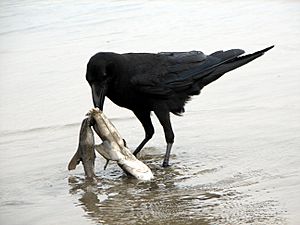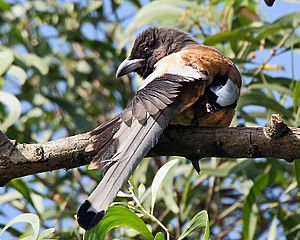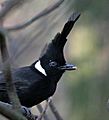Corvids facts for kids
Quick facts for kids Corvids |
|
|---|---|
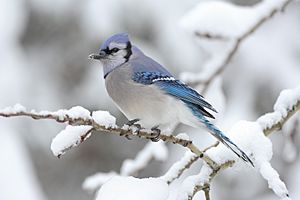 |
|
| Blue jay Cyanocitta cristata |
|
| Scientific classification |
|
| Kingdom: | Animalia |
| Phylum: | Chordata |
| Class: | Aves |
| Order: | Passeriformes |
| Superfamily: | Corvoidea |
| Family: | Corvidae Leach, 1820 |
| Genera | |
|
See text |
|
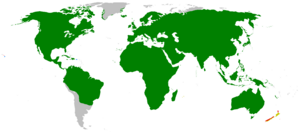 |
|
| Distribution map of the Corvidae.
Native (Re)Introduced
Extinct (post-1500) Extinct (pre-1500)
|
|
Corvids, also known as the crow family, are a group of smart birds found all over the world. This family includes well-known birds like crows, ravens, magpies, and jays. There are currently 135 different types of corvids. The Corvus group, which includes crows and ravens, has 47 species, making up more than a third of the whole family. Ravens are actually the largest songbirds!
Corvids are known for being incredibly smart for their size. They are among the most intelligent birds ever studied. For example, Eurasian magpies have shown they can recognize themselves in a mirror. Crows and rooks have even shown they can make and use tools. These skills were once thought to belong only to humans and some other smart mammals. Corvids have a brain-to-body size ratio similar to that of apes and dolphins.
These birds are medium to large in size. They have strong feet and powerful beaks. Most corvids change their feathers once a year. You can find corvids almost everywhere in the world, except for the very southern tip of South America and the icy polar regions. Most species live in warm areas like South and Central America and southern Asia.
Contents
Bird Family Tree: Corvids
The name Corvidae was first used by a British zoologist named William Elford Leach in 1820. Scientists have spent many years trying to figure out how corvids are related to each other and to other bird families. It seems that corvids originally came from Australasia (Australia and nearby islands) and then spread across the world.
Scientists use DNA sequences to understand how different corvid species are related. This helps them create a "family tree" for these birds. For example, jays and magpies don't all belong to one single group. Instead, they split into different groups, like those found in the Americas versus those in the Old World (Europe, Asia, Africa).
Some birds that were once thought to be corvids are actually not. For example, the crested jayshrike is now believed to be closer to helmetshrikes. Also, the Hume's ground "jay" is actually a type of tit.
Here is a simplified family tree showing how some corvid groups are related:
| Corvidae |
|
||||||||||||||||||||||||||||||||||||||||||||||||||||||||||||||||||||||||||||||||||||||||||||||||||||||||||||||||||||||||||||||||||||||||||
Corvid Fossils
The oldest corvid fossils found are about 17 million years old, from Europe. These ancient birds, like Miocorvus and Miopica, might be ancestors of today's crows and magpies. Many other fossil species of corvids have been found, especially in Europe.
What Corvids Look Like

Corvids are large birds with strong bodies and powerful legs. All species, except the pinyon jay, have feathers covering their nostrils. Many corvids in cooler areas are black or blue. Some have black and white feathers, while others have shiny blue-purple feathers. Many tropical species are brightly colored. Male and female corvids usually look very similar in color and size. They have strong, thick beaks and large wings. Corvids include some of the biggest birds in the passerine order (songbirds).
The smallest corvid is the dwarf jay, which weighs about 41 grams (1.4 ounces) and is 21.5 cm (8.5 inches) long. The largest corvids are the common raven and the thick-billed raven. Both can weigh over 1400 grams (3 pounds) and be longer than 65 cm (25 inches).
You can often tell different corvid species apart by their size, shape, and where they live. However, some, especially the Australian crows, are best identified by their loud calls.
Where Corvids Live and How They Interact with Nature
Corvids live in most types of climates. Most of them stay in one place and do not migrate long distances. But if food is scarce, they might move to new areas. When species do migrate, they form large groups in the fall and fly south.
Crows have been very successful because they can share breeding areas more easily than ravens. This allows more crows to live in the same place.
Some people worried that as crows and magpies increased in numbers due to human development, they might eat more eggs and chicks of smaller birds. However, studies have shown that this concern is mostly unfounded. For example, Steller's jays, which are successful on their own, are better at raiding nests than American crows and common ravens. So, human activity hasn't greatly increased nest predation by crows and ravens compared to other problems like habitat destruction.
Corvid Behavior
Some corvids have strong social groups. For example, jackdaws live in a clear social order and often nest together in colonies. Many corvid species have also been seen helping each other.
Young corvids love to play and take part in complex social games. They play games like "king of the mountain" or "follow the leader." They also play with sticks, passing them around and balancing them. Corvids even slide down smooth surfaces for fun! These games help the birds learn important skills for survival.
Choosing a mate is quite complicated for corvids and involves a lot of social play. Young corvids in social groups go through many "tests," including flying stunts, before another bird accepts them as a mate.
Some corvids can be aggressive. Blue jays are known to attack anything that threatens their nest. Crows have even attacked dogs, cats, ravens, and birds of prey. Most of the time, these attacks are just a distraction to allow the corvid to steal food.
What Corvids Eat
Many corvid species eat a variety of foods. Their natural diet includes insects, young birds, small mammals, berries, fruits, seeds, and dead animals (carrion). However, some corvids, especially crows, have learned to live near humans and often eat human food. A study in the US found that crows near campsites ate many human foods like bread, spaghetti, and hot dogs. More human food sources are helping some corvid populations grow.
Some corvids also hunt other birds. In winter, corvids often form groups to find food. Some crows also eat many farm pests, like grasshoppers. Some corvids eat dead animals, but since they don't have beaks designed for tearing meat, they have to wait for other animals or cars to open up the carcass.
How Corvids Reproduce
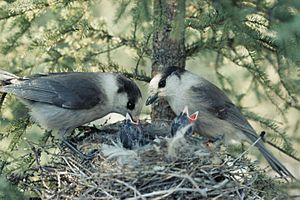
Many corvid species protect their own areas, either all year or just during breeding season. Some corvids are known to gather in large groups to sleep at night. For example, a group of 65,000 rooks was counted sleeping together in Scotland. Some, like rooks and jackdaws, also nest together in groups.
The bond between male and female corvids is very strong, and in some species, it lasts their whole lives. The male and female build large nests together in trees or on ledges. Jackdaws are known to nest in buildings and rabbit burrows. The male also feeds the female while she sits on the eggs. Nests are made of twigs and lined with grass and bark. Corvids usually lay between 3 and 10 eggs, most often 4 to 7. The eggs are usually greenish with brown spots. Once hatched, the young birds stay in the nest for 6 to 10 weeks, depending on the species.
Corvids use different ways to care for their young. Both parents might care for the chicks, or sometimes other adults help raise the young. These "helpers" are usually relatives, but sometimes they are unrelated adults.
Corvid Intelligence
Scientists believe that the size of an animal's brain compared to its body size can show how smart it is. Corvids and parrots have larger brains for their body size than other birds, similar to apes. Among corvids, ravens have the largest brain-to-body size ratio. Corvids' intelligence is also boosted by their environment. They live in tough places where being smart helps them survive. Also, since most corvids eat many different things, they learn about many different environments. Many corvid species live in large family groups, which also makes them smarter.
Their intelligence also grows because their young stay with their parents for a long time. This gives the young birds more chances to learn important skills.
In one experiment, corvids were better than dogs and cats at finding food using clues. A study in 2004 suggested that corvids are as smart as apes. Even though their brains are built differently, corvids and apes both learned to understand shapes and distances.
Showing Feelings
Ravens have been seen comforting other ravens after a fight. This is like showing empathy, where they understand and share another's feelings. Ravens seem to be sensitive to the emotions of others.
Scientists have also studied how emotions can spread between ravens. They found that if one raven was in a bad mood, other ravens watching it would also show signs of being pessimistic. This suggests that ravens can "catch" negative emotions from each other.
Talking to Humans
Humans often use facial expressions to show emotions. Scientists have studied if birds can understand human non-verbal communication. A study with American crows found that crows change their behavior when a human looks directly at them. This shows that crows are smart enough to adapt well to living near humans.
Group Personalities
It's hard to study animal emotions because we can't talk to them. One way to learn about an animal's personality is to watch how consistently it behaves over time. For animals that live in groups, scientists have two ideas: either individuals become unique, or they become more similar to their group. A study on Mexican Jays and California Scrub-Jays found that birds in a group tend to become more similar in their personalities.
How Social Life Shapes Personality
A bird's personality is shaped by both its genes and its social environment. A study on ravens and carrion crows showed that living with other birds made individuals behave more similarly. This means that social life has a big impact on how a raven's or crow's personality develops.
Smart from Social Life
The idea that living in a social group makes animals smarter is called the social complexity hypothesis. Corvids show their cleverness through how they find food, their amazing memorization skills, using tools, and their group behavior. Living in large groups has long been linked to high intelligence. To live in a big group, a bird needs to recognize other individuals. It also needs to remember their social rank and where they find food. Birds must also tell the difference between males and females, young and old, and dominant or submissive birds, and keep this information updated. It's possible that living in complex social groups helps corvids become smarter and helps information spread among them.
Consciousness and Culture
The Eurasian magpie is the only non-mammal known to recognize itself in a mirror test. However, other studies couldn't always repeat this finding with magpies or other corvids. Magpies have been seen performing special "grieving rituals" that are similar to human funerals, like placing grass wreaths. Some scientists believe this shows magpies can feel complex emotions, like grief. Also, studies on carrion crows show that their brains react to what they see in a way that suggests they have a basic form of sensory consciousness—meaning they are aware of what they are experiencing.
Tool Use, Memory, and Thinking
Corvids are very clever. One carrion crow was seen cracking nuts by placing them on a crosswalk, letting cars run over them, and then waiting for the traffic light to turn red to safely pick up the nut pieces. A group of crows in England took turns lifting garbage bin lids while others collected food.
Corvids have been known to watch other birds, remember where they hide their food, and then steal it when the owner leaves. Corvids also move their own hidden food to new spots to prevent theft. They only do this if they themselves have stolen food before. This means they remember past experiences and use them to predict what other birds might do. Studies on apes haven't shown this same ability clearly.
Hiding food requires a very good memory for places. Corvids can remember where they hid food up to nine months later. They seem to use tall landmarks, like trees, to remember locations. There's also evidence that California scrub jays, which store food that can spoil, remember not only where they stored it but also for how long. This is similar to episodic memory, which was once thought to be unique to humans.
New Caledonian crows are famous for making tools. They trim twigs and leaves into hooks and use them to pull insect larvae from tree holes. They design their tools for the specific task. Other corvids seen using tools include the American crow, blue jay, and green jay. Researchers have found that New Caledonian crows can even build new tools by putting together different pieces that wouldn't work on their own. The different tool designs among corvids suggest they have different "cultures." Again, apes are the only other animals known to use tools in such a complex way.
Corvids and Scarecrows
Scarecrows are often used by farmers to keep birds away from crops. However, because corvids are so smart, they quickly learn to ignore scarecrows and even use them as perches! Despite farmers' efforts, corvids have often expanded their territories and grown in numbers.
Corvids are not closely related to parrots, which are another group of very intelligent birds.
A study found that four-month-old ravens can have physical and social thinking skills similar to adult apes. This shows how quickly their minds develop.
Diseases Affecting Corvids
Corvids can carry the West Nile virus in the United States. They get infected by mosquitoes. Crows and ravens often die quickly from this disease. So, their deaths can be an early warning sign that West Nile virus has arrived in an area. For example, when the West Nile virus first appeared in the US in 1999, one of the first signs was the death of crows in New York.
Corvids and People
Some corvids, especially ravens, have been kept as pets. However, they don't learn to speak as easily as parrots and are not suited to living in cages.
In North America, it is against the law to own corvids or any other migratory bird without a special permit.
Humans and many corvids, especially crows and ravens, have lived together for a long time. These positive interactions continue today.
Corvids in Stories and Culture
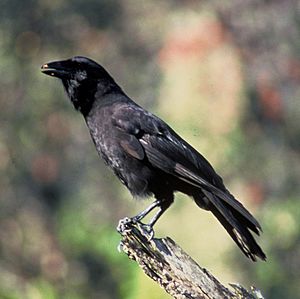
In old stories, corvids are often shown as clever and even magical animals. Some Native American groups, like the Haida, believed that a raven created the earth. Even though ravens were sometimes seen as tricksters, they were popular on totems. They were credited with creating humans and placing the Sun in the sky.
Because they eat dead animals, the Celtic people strongly linked corvids with war and death. Their great intelligence meant they were often seen as messengers or even gods. In many parts of Britain, people count groups of crows or magpies using a special rhyme to predict the future: "one for sorrow, two for joy, three for a girl, four for a boy, five for silver, six for gold, seven for a secret never to be told."
Various Germanic peoples greatly respected the raven. Ravens were often shown on shields or other war gear in Anglo-Saxon art. The main god, Odin, was so connected with ravens that he was called "Raven God." The raven banner was a flag used by Viking Age leaders. Odin also had two ravens, Hugin and Munin, who flew around the world and whispered information into his ears.
The Greek writer Aesop, who lived in the 6th century BCE, often featured corvids as smart characters in his fables. Later, in Western literature, the common raven became a symbol of a character's journey into madness in Edgar Allan Poe's famous poem "The Raven".
The children's book Mrs. Frisby and the Rats of NIMH and its animated movie version feature a crow named Jeremy.
Corvid Status and Protection
Unlike many other bird families, many corvid species, especially crows, have actually increased in number because of human development. Their survival and ability to have young are helped by their close relationship with humans.
Human development creates more resources for corvids by clearing land. This creates areas with lots of berries and insects. When these cleared lands grow back, jays and crows use the young, dense trees for nesting. Ravens usually prefer larger trees in thicker forests.
Even though most corvids are not in danger (many are even increasing), a few species are threatened. For example, the destruction of rainforests in Southeast Asia is endangering some corvid species. Also, the Florida scrub jay has a small and shrinking population because its dry scrubland habitat is disappearing. A number of island species, which are more easily affected by new animals brought to their islands and by habitat loss, have become extinct, like the New Zealand raven, or are threatened, like the Mariana crow.
The American crow population in the United States has grown over the years. It's possible that because humans are creating more suitable places for American crows to live, this might cause the numbers of Northwestern crows and fish crows to go down.
Main Species of Corvids
The corvid family includes:
Images for kids
-
Yellow-billed blue magpie, Urocissa flavirostris
-
Eurasian jay (Garrulus glandarius)
-
Eurasian magpie, Pica pica
-
Plush-crested jay, Cyanocorax chrysops
-
Common raven, Corvus corax
-
Hooded crow, Corvus cornix
-
Thick-billed raven, Corvus crassirostris
-
Australian raven, Corvus coronoides
-
Crested jayshrikes were once thought to be corvids.
See also
 In Spanish: Córvidos para niños
In Spanish: Córvidos para niños


